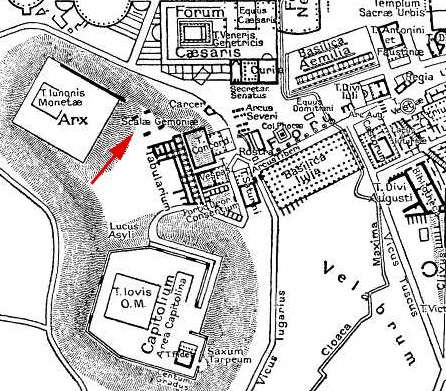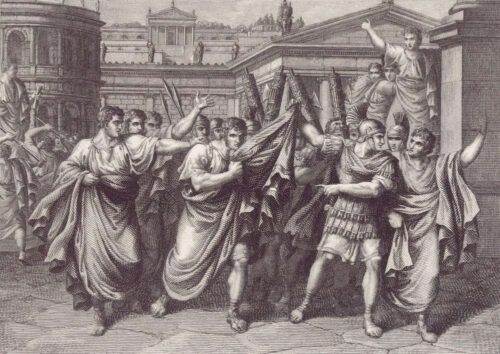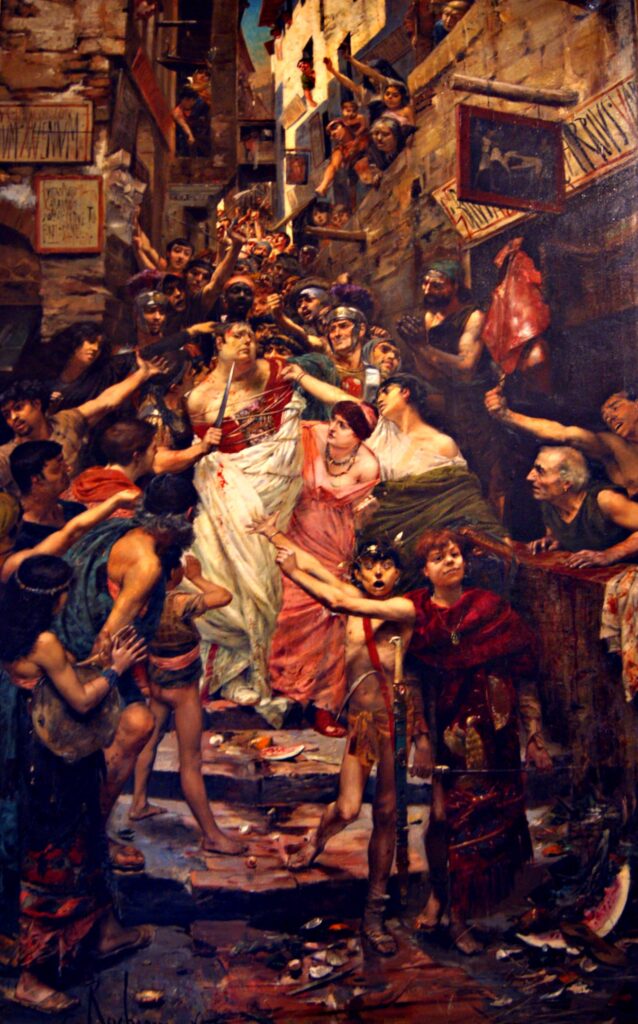The Scalae Gemoniae (Gemonian Stairs) was a set of stairs connected to the Capitoline Hill that was used as a method of punishment for those criminals who had disgraced Rome.
Purpose of Gemonian Stairs
Like its gruesome counterpart, the Tarpeian Rock, the Gemonian Stairs were used for criminals that the Romans wanted to disgrace. Whereas the Tarpeian Rock was used to throw the worst criminals off to their deaths, the Gemonian Stairs were used differently to shame the names of its victims.
What would happen to those who were condemned to a shameful death is that the person would be killed at the top of the stairs and then thrown down the stairs. The body would be left there for a few days to be ravaged by dogs and carrion birds before finally being tossed into the Tiber River.
Location of Gemonian Stairs
According to Samuel Ball Platner’s A Topographical Dictionary of Ancient Rome, the Scalae Gemoniae was a flight of steps leading up to the Capitoline past the carcer (prison). It is not entirely certain where the stairs started and finished, but it connected the Capitoline Hill to the Roman Forum.
There are modern stairs in its place, roughly matching the Via di San Pietro in Carcere.
There is a narrow set of stairs a short walk away from what is generally considered the Gemonian Stairs – down the road (Via di San Pietro in Carcere), past the Tabularium and it runs alongside the old Mamertine Prison. This is likely the location of the stairs (or at least the end of the stairs – the two sets of stairs must have linked up together in antiquity).
Historians are also not certain of when the stairs were built as there was no explicit mention of its construction anywhere in the historical records.
My opinion of the age of this is that the stairs have been there since Republican times, with the stairs’ naming and usage for punishment coming at a much later date.

It would also be interesting to know why the stairs were named the Gemonian Stairs, but we do not have that information. My opinion is that it was named after someone who betrayed or wronged Rome in some regard and was killed on the stairs.
One of the earliest references to the stairs was during the reign of Tiberius (AD 14-37). When writing about the trial of Piso – the man accused of poisoning Germanicus – Tacitus, in his book, Annals, describes a mob outside the court baying for the blood of the accused. Book III, XIV:
“At the same time, shouts were heard: it was the people at the senate doors, crying that, if he escaped the suffrages of the Fathers, they would take the law into their own hands. They had, in fact, dragged his effigies to the Gemonian Stairs and were engaged in dismembering them when they were rescued and replaced at the imperial command. He was therefore put in a litter and accompanied home by an officer of one of the praetorian cohorts, while rumor debated whether the escort was there for the preservation of his life or the enforcement of his death.”
Tiberius raised suspicion about his own involvement in the death of Germanicus by being overly cruel to his widow, Agrippina. In his book, The Lives of the Caesars – the Life of Tiberius, LIII, Suetonius outlines the depraved way he treated his daughter-in-law and why people should be thankful that he didn’t treat her worse:
“When his daughter-in‑law Agrippina was somewhat outspoken in her complaints after her husband’s death, he took her by the hand and quoted a Greek verse, meaning, “Do you think a wrong is done you, dear daughter, if you are not empress?” After that, he never deigned to hold any conversation with her. Indeed, after she showed fear of tasting an apple which he handed her at dinner, he even ceased to invite her to his table, alleging that he had been charged with an attempt to poison her; but as a matter of fact, the whole affair had been pre-arranged, that he should offer her the fruit to test her, and that she should refuse it as containing certain death. At last, falsely charging her with a desire to take refuge, now at the statue of Augustus and now with the armies, he exiled her to Pandataria, and when she loaded him with reproaches, he had her beaten by a centurion until one of her eyes was destroyed. Again, when she resolved to die of starvation, he had her mouth pried open and food crammed into it. Worst of all, when she persisted in her resolution and so perished, he assailed her memory with the basest slanders, persuading the senate to add her birthday to the days of ill omen and actually taking credit to himself for not having had her strangled and her body cast out on the Stairs of Mourning. He even allowed a decree to be passed in recognition of this remarkable clemency, in which thanks were offered him and a golden gift was consecrated to Jupiter of the Capitol.”
It must be noted that the Gemonian Stairs were sometimes referred to as the Stairs of Mourning. The above passage may also serve as an excellent reminder to treat the literal words with skepticism at times, as some details can be exaggerated. We know that Tiberius was not a well-liked individual. While he did do some bad things, the finer details may, at times, be exaggerated.
Famous Victims
Some famous victims of the Gemonian Stairs included Tiberius’ Praetorian Prefect, Lucius Aelius Sejanus, Titus Flavius Sabinus (brother of Emperor Vespasian), and Emperor Vitellius.
Sejanus rose through the ranks to become Praetorian Prefect and became a quasi-emperor as Emperor Tiberius had spent several years in his palace on the island of Capri. Sejanus was entrusted to look after the affairs of the state in Rome.
It is not precisely clear why Sejanus was arrested in AD 31. Many suspect that he was trying to seize power for himself. While not proven, this could explain why Tiberius thought he should be put to death without a trial.

As Cassius Dio notes in his Roman History regarding the swift downfall of Sejanus, Book LVIII, XI:
“Thereupon, one might have witnessed such a surpassing proof of human frailty as to prevent one’s ever again being puffed up with conceit. For the man whom at dawn they had escorted to the senate hall as a superior being, they were now dragging to prison as if no better than the worst; on him whom they had previously thought worthy of many crowns, they now laid bonds; him whom they were wont to protect as a master, they now guarded like a runaway slave, uncovering his head when he would fain cover it; him whom they had adorned with the purple-bordered toga, they struck in the face; and him whom they were wont to adore and worship with sacrifices as a god, they were now leading to execution. The populace also assailed him, shouting many reproaches at him for the lives he had taken and many jeers for the hopes he had cherished. They hurled down, beat down, and dragged down all his images as though they were thereby treating the man himself with contumely, and he thus became a spectator of what he was destined to suffer. For the moment, it is true; he was merely cast into prison, but a little later, in fact, that very day, the senate associated in the temple of Concord not far from the jail, when they saw the attitude of the populace and that none of the Pretorians was about, and condemned him to death. By their order he was executed and his body cast down the Stairway, where the rabble abused it for three whole days and afterwards threw it into the river.”
Suetonius goes on to note the cruelty of Tiberius (Suetonius clearly does not like the guy!) continued after the death of Sejanus. While the plebeians lived in a state of constant fear, As noted in chapter LXI:
“Some of those who were consigned to prison were denied not only the consolation of reading but even the privilege of conversing and talking together. Of those who were cited to plead their causes, some opened their veins at home, feeling sure of being condemned and wishing to avoid annoyance and humiliation, while others drank poison in full view of the Senate. Yet, the wounds of the former were bandaged, and they were hurried, half-dead but still quivering, to the prison. Every one of those who were executed was thrown out upon the Stairs of Mourning and dragged to the Tiber with hooks, as many as twenty being so treated in a single day, including women and children.”
However, upon hearing of the death of Tiberius, the plebeians had the last laugh, threatening to meet out the same punishment that he inflicted on so many others. As noted by Suetonius in chapter LXXV:
“The people were so glad of his death that at the first news of it, some ran about shouting, “Tiberius to the Tiber,” while others prayed to Mother Earth and the Manes to allow the dead man no abode except among the damned. Still, others threatened his body with the hook, and the Stairs of Mourning, especially embittered by a recent outrage, added to the memory of his former cruelty.”
During the year of the four emperors (AD 69), Titus Flavius Sabinus (the brother of future emperor Vespasian) held the position of Urban Prefect (praefectus urbi) under Emperor Vitellius.
He had been loyal to Vitellius, managing the transition of power from the previous emperor, Otho, to Vitellius by instructing troops and urban cohorts to submit to his leadership. However, things changed when the legions in Judea proclaimed Vespasian their emperor.
Vitellius tried to hand over the empire to Sabinus (to then hand over to Vespasian) after Vitellius suffered significant military defeats by supporters of Vespasian. However, some Vitellian supporters were unhappy with this arrangement and besieged the Capitol, leaving Sabinus and his nephew (future emperor Domitian) trapped.
Domitian was able to conceal himself and escape. However, Sabinus was one of the unlucky ones caught by Vitellius’ troops.
As noted by Tacitus in his book, Histories, Book III, LXXIV, the crowd was baying for blood and eventually got their way:
“Vitellius stood on the steps of the palace and was about to appeal to them when they forced him to withdraw. Then they ran Sabinus through, mutilated him, and cut off his head, after which they dragged his headless body to the Gemonian stairs.”
Emperor Vitellius suffered the same fate soon afterward after being on the losing side of the Vitellian-Vespasian civil war. He was summarily rounded up, killed, and flung down the Stairs of Mourning (I can see where it gets its name from!).

Tacitus attested to this in Book III, LXXXV:
“Vitellius was forced at the point of the sword now to lift his face and offer it to his captors’ insults, now to see his own statues falling, and to look again and again on the rostra or the place where Galba had been killed. Finally, the soldiers drove him to the Gemonian stairs where the body of Flavius Sabinus had recently been lying. His only utterance marked his spirit as not ignoble, for when the tribune insulted him, he replied, “Yet I was your Emperor.” Then he fell under a shower of blows; and the people attacked his body after he was dead with the same base spirit with which they had fawned on him while he lived.”
The Romans certainly knew how to meet out punishment to their fellow man and spared no amount of gore in the process. Ancient civilizations can be quite brutal.
Sources:
SB Platner – A Topographical Dictionary of Ancient Rome (Thayer) – https://penelope.uchicago.edu/Thayer/E/Gazetteer/Places/Europe/Italy/Lazio/Roma/Rome/_Texts/PLATOP*/home.html
Tacitus – Annals (Thayer) – https://penelope.uchicago.edu/Thayer/E/Roman/Texts/Tacitus/Annals/3A*.html#ref34
Suetonius – The Lives of the Twelve Caesars (Thayer) – https://penelope.uchicago.edu/Thayer/E/Roman/Texts/Suetonius/12Caesars/Tiberius*.html#ref:Scalae_Gemoniae
Cassius Dio – Roman History (Thayer) – https://penelope.uchicago.edu/Thayer/E/Roman/Texts/Cassius_Dio/58*.html#11.1
Tacitus – The Histories (Thayer) – https://penelope.uchicago.edu/Thayer/E/Roman/Texts/Tacitus/Histories/3C*.html
Featured Image: By Peter1936F – Own work, CC BY-SA 4.0

